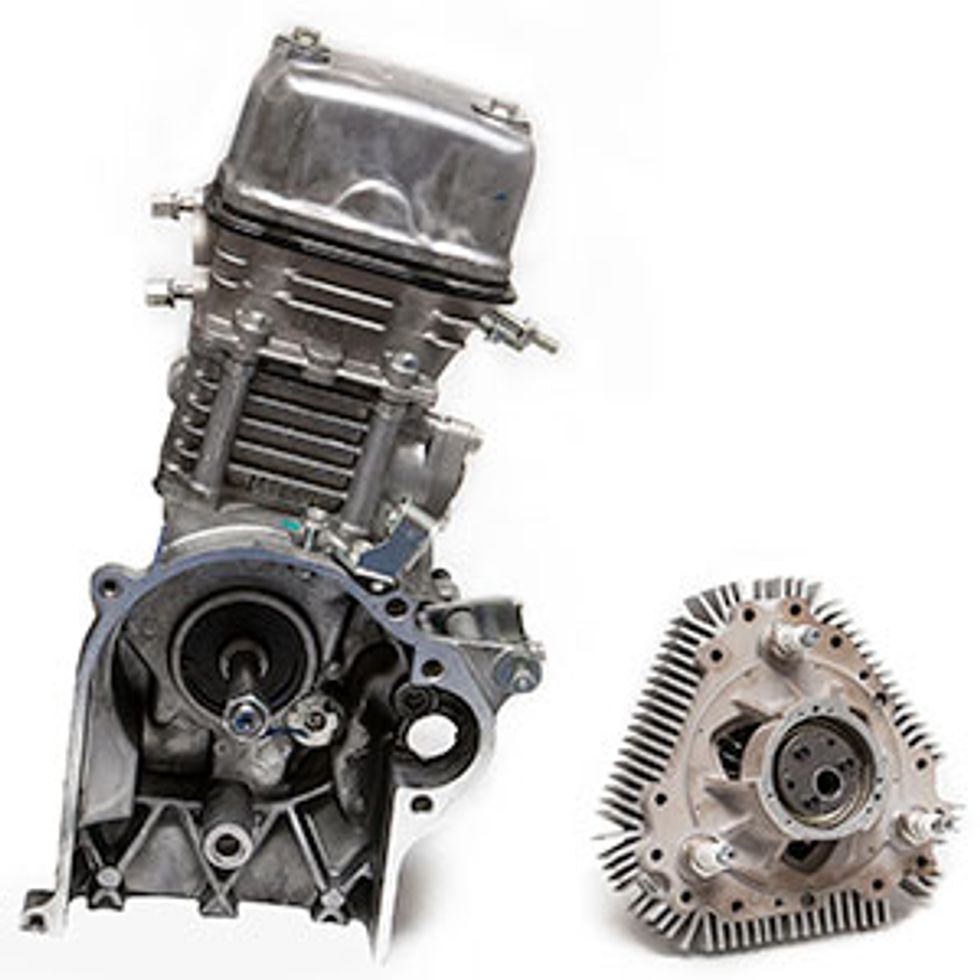A new kind of engine has showed its stuff for the first time outside the lab, and though it merely made a go-kart go, it could well be the start of something big.
The engine is a rotary design, a pistonless setup that maximizes the power-to-weight ratio. It’s the fruit of a dozen-odd years of work by LiquidPiston, a startup co-founded by Alec Shkolnik, who has a Ph.D. in computer science, with a specialization in AI and modeling. The engine itself is based on combustion technology developed by his father, Nikolay, a Soviet-trained mechanical engineer who retrained in the United States as a physicist.

There’s no liquid, though, and no piston: The company has outgrown a name that referred to a design that used both to convert expanding gas into propulsive force. Now, half a dozen iterations later, the result is an all-metal rotary engine that’s decidedly not your father’s Wankel, the famous, humming heart of the Mazda RX series.
“It’s kind of a Wankel flipped inside out, a design that solves the old problems with sealing and fuel consumption,” says company founder Alec Shkolnik. “The Wankel has a triangular rotor inside a peanut-shaped housing; we have a peanut-shaped rotor inside a triangular housing. Our seals go at the apexes of the triangle [...] and our seals are stationary because they’re in the housing.”
The seals stop gas from moving from one chamber to another. In a Wankel, the seals move rapidly, and that makes them hard to lubricate. You have to spray oil into the combustion chamber knowing that only a fraction will reach the seals and the rest will go up in smoke—a problem for both fuel economy and engine emissions. LiquidPiston’s engine lacks that baggage but retains the rotary engine’s intrinsic mechanical simplicity—just a rotor and an eccentric shaft, together with fuel injectors, fuel pumps and oil pumps.
Shkolnik admits that his machine is hardly ready yet for the auto industry’s 100,000-mile durability standard. But he argues that even in its teething stages it should find application in any field that prizes a tiny, fuel-efficient simple motor that packs a lot of power into a small volume and mass.
“We’ve replaced the go-kart’s 40-lb engine with our 4-lb, 3 to 5 horsepower engine,” Shkolnik says. As of today, you can buy the developer’s kit.
The engine is more efficient than a Wankel becaues it has a higher compression ratio and because the shifting geometry of its internal cavities lets it extract most of the energy of the exhaust gases before voiding them, a feature called over-expansion.
“Toyota uses the Atkinson cycle in its Prius, and that does overexpansion—so it’s not new,” he says. “But the Prius engine is oversized. We get over-expansion almost for free, just by changing the location of our [valve] port. We don’t have to have clunky valve trains to achieve that.”
A valve train is the camshaft-operated system that opens and closes the valves in a piston engine’s combustion chamber to let fuel and air in and exhaust gases out. Turning that shaft consumes energy—a “parasitic loss,” in the automotive lingo.
LiquidPiston’s grapefruit-size, 1.5-kilogram power plant is just the ticket for a medium-duty, propeller-powered drone. That’s why the U.S. military is interested in it: the company has received funding from the Defense Advanced Military Research Projects Agency, or DARPA.
“Many people immediately try to sell improved engines to the automotive and truck market, and I can’t blame them, it’s a $300 billion market,” Shkolnik says. “But to bring a new engine to life in the automotive world takes at least seven years and costs, quite literally, $500 million—and that’s for a piston engine, where the risk is low.”
So he’s looking first at markets that have an urgent need for very compact engines—hand-held power tools, cargo-carrying drones for the likes of Amazon and FedEx, and most interestingly, range extenders for cars.
“We have the concept of a 30-kilowatt engine operating on diesel, 30 lbs, in a 10 by 8 inch box,” Shkolnik says. “It could be part of an e-vehicle for masses, giving you the range you’re accustomed to—300 miles instead of 30—and rapid refueling.”
To be sure, the Wankel has also been suggested as a range extender. And though LiquidPiston’s engine can claim to be—or to be capable of becoming—more efficient and more compact than a Wankel, these things may not matter all that much when the machine is working only in a helper mode.
Radical new engine designs crop up all the time, but they rarely make the big time. Remember the gas turbines of the 1960s? The superhot, superefficient ceramic engine of the 1980s? The radically improved two-stroke engine whose exhaust was going to be cleaner than the ambient air? Even the Wankel repeatedly failed until Mazda’s engineers rolled up their sleeves and made its success a priority.
The saving grace of LiquidPiston, though, is the ever-expanding range of uses for engines of all kinds. Even if no car ever runs solely on one of its products, there are plenty of market niches it could fill: hybrids, drones, maybe even chain saws.
Editor’s note: the passage referring to gas seals has been reworded for clarity.
Philip E. Ross is a senior editor at IEEE Spectrum. His interests include transportation, energy storage, AI, and the economic aspects of technology. He has a master's degree in international affairs from Columbia University and another, in journalism, from the University of Michigan.



